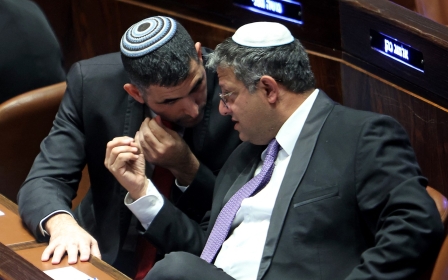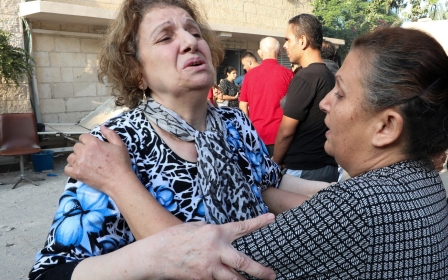Israel-Palestine war: Colleagues remember slain Palestinian journalist Rushdi al-Saraj

Friends and colleagues are remembering the Palestinian photojournalist Rushdi al-Saraj, who was killed in his home by an Israeli air strike on 22 October, according to local media reports.
The director of Gaza’s Ain Media organisation, Saraj died days after his colleague Ibrahim Lafi was also killed in an Israeli air strike.
According to Radio France Internationale (RFI), a news outlet Saraj had been working for as a fixer for its Gaza coverage since 2021, the 31-year-old was killed in the Tel al-Hawa neighbourhood of Gaza City.
“Despite the dangers of wartime, he preferred to stay at home in the northern Gaza Strip, explaining that his family had fled Jaffa in 1948 and that he did not want to relive a second Nakba,” said the former RFI correspondent in Jerusalem, Frederic Metezeau in an interview with the station.
Saraj's wife and 11-month-old daughter were also injured in the strike, Radio France reported.
New MEE newsletter: Jerusalem Dispatch
Sign up to get the latest insights and analysis on Israel-Palestine, alongside Turkey Unpacked and other MEE newsletters
“He was the one who informed us first, the one who risked his life, at a time when no one can enter,” said RFI journalist Alice Froussard, on X, formerly Twitter.
During the course of his career, Saraj had built a reputation for reliability in his work with news outlets and international human rights organisations.
Also on X, Agnes Callamard, the secretary general of Amnesty International, wrote:
“We have lost a friend and colleague: Rushdi Saraj, who worked with @Amnesty on a short film, was murdered today in an Israeli air strike. Rushdi was a talented film maker and journalist - another victim of Israel bombing of Gaza.”
At least 23 journalists have been killed since 7 October, when Hamas launched an unprecedented attack in southern Israel, killing around 1,400 people and taking at least 200 people hostage.
Israel's response has killed at least 5,000 Palestinians in Gaza, the vast majority civilians.
Showing the 'other side' of Gaza
At least 19 Palestinian journalists have been killed so far in the conflict. Three Israeli journalists have also been killed, including photographer Yaniv Zohaf, who previously reported for AP.
Zohaf was killed during the attack on Kibbutz Nahal Oz in southern Israel on 7 October.
Saraj was interviewed days before his death by The Washington Post, about the killing of his Palestinian colleagues during the war.
“Rushdi spoke of his late Palestinian colleagues with pride,” Jennifer Hassan, a breaking news reporter for The Washington Post, wrote on X. “Today we discovered that Rushdi was killed in an Israeli airstrike on his home.”
We have lost a friend and colleague: Rushdi Saraj, who worked with @Amnesty on a short film, was murdered today in an Israeli air strike. Rushdi was a talented film maker and a journalist - another victim of Israel bombing of Gaza https://t.co/yHAmSL1Iwe
— Agnes Callamard (@AgnesCallamard) October 22, 2023
In a 2016 interview with UNRWA, Saraj spoke about how life in Gaza, though difficult under Israeli restrictions, was about much more than suffering, poverty, misery and destruction.
“I am a Palestinian refugee and I can reflect life in Gaza to the world because I am a part of it; but I also want to show the other side of Gaza, the hope, the happiness and the love,” Saraj said.
Palestinian journalists have been working in life-threatening conditions to share stories about the suffering of their community in Gaza, where an Israeli siege has severed access to water and power and there are no international journalists.
But the targeting of journalists in Gaza did not begin with the most recent Israeli siege, and Saraj had previously lost colleagues to Israeli army fire.
Follow Middle East Eye's live coverage for the latest on the Israel-Palestine war
Five years ago, he was working with his friend and fellow Palestinian photojournalist Yaser Murtaja when 30-year-old Murtaja - who was wearing a clearly marked “PRESS” flak jacket - was shot and killed by Israeli forces.
Israel denied it had targeted Murtaja, who was covering a protest by Palestinians in Gaza who were demanding their return to lands lost to Israel during the Nakba.
Together, Saraj and Murtaja had founded a media company that liaised with international news organisations with the aim of providing coverage from Gaza.
Protection for journalists
The protection of journalists as civilians is a requirement under international law, including UN Security Council Resolution 2222/2015, which relates to the protection of journalists and associated media personnel in situations of conflict.
Israel has a history of killing Palestinian journalists, including veteran Palestinian-American Al Jazeera journalist Shireen Abu Akleh, who was shot dead by an Israeli soldier in the occupied West Bank city of Jenin on 11 May 2022 while covering an Israeli military operation.
Initially, Israel accused Palestinian gunmen of killing Abu Akleh but later accepted responsibility, claiming a bullet aimed at Palestinian gunmen “accidentally hit” Abu Akleh.
“In previous attacks and killings of journalists by the Israeli army, we saw no serious attempts to impartially investigate or hold those responsible accountable,” said Amr Magdi, a senior researcher for the Middle East and North Africa at Human Rights Watch.
“It speaks to the impunity Israeli soldiers enjoy, backed by unconditional western support that is largely based on interests rather than values,” Magdi added, in comments made after the recent Israeli attack on journalists in Lebanon, which killed Reuters journalist Issam Abdallah.
“The ongoing ICC investigation into crimes in Israel/Palestine by all parties should include a special focus on attacks against media workers and journalists," Magdi said.
Middle East Eye delivers independent and unrivalled coverage and analysis of the Middle East, North Africa and beyond. To learn more about republishing this content and the associated fees, please fill out this form. More about MEE can be found here.





